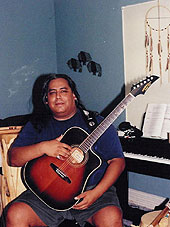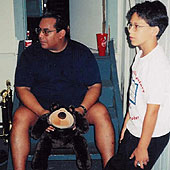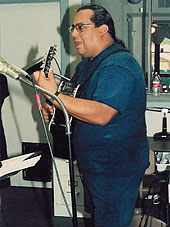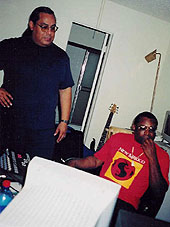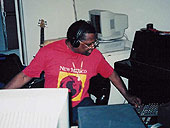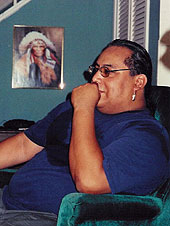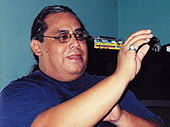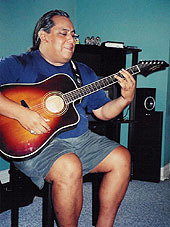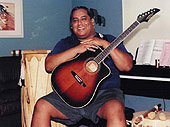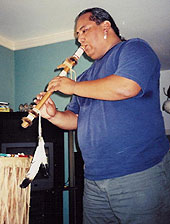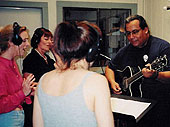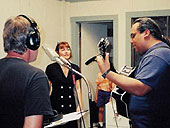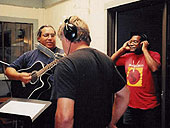Learning Library Segments
Titos Menchaca
Primary Use of Medium: Story TellingInterviewer: Donna Wetegrove
Interview Location Note, this interview process takes place with Titos Menchaca in his home studio with lots of the Austin summer sun streaming in the window. It is a hot, late summer Texas afternoon with no prediction of some much-needed rain. This south Austin neighborhood is quite peaceful and Titos' three young sons are very understanding and willing to share their dad with us for a couple of hours.
Interview Date: 7.29.02
Writer: Carol Gonzales
Inspiration
Art Form/Product
Green Aspects
Marketing Values
Special Offering
Additional Comments
Artist Profile
Inspiration
"I describe what I do as tribal soul ." "My own ambition is to serve creation."What Type Of Artist/Musician Do You See Yourself As?
"I think first and foremost I consider myself a songwriter, before a performer. I think that if I have a gift it is really in the melodic structure and, I've discovered as I've gone through this process, I'm a pretty good arranger also." Titos was classically trained as a horn player from the time he was 11 years old and has been a musician for 32 years now. And, he admits, his journey and the whole process still hold a sense of "mystery" to him.
It is that composer side of Titos that helps him hear all of the elements of the song. "I hear rhythm tracks, I hear lead parts, I hear harmonies ." At this point in his career, Titos is able to isolate these elements and remix them because he now has a home studio and access to any other equipment he needs through contacts he has made over the years in the business. This is a landmark time for Titos as he works on the release of his first CD, "Sacred Ground". "This project is really the culmination for me; some of these songs I wrote 10, or 12 or 15 years ago, and some of them I wrote last year ... and everything in between."
How Did You Get Here To This Place In Your Career?
"Growing up in Austin, I had exposure to such a diverse range of influences in this town. I had classical growing up, I was really into jazz for a while, and just by osmosis you pick up country and folk around here. I have loved folk music for a long time I love story telling."
It is not hard for Titos to recall the significant influences. "Harry Chapin was one of my favorite performers and writers and I loved that whole folk era." James Taylor, Cats Stevens, and Simon & Garfunkel also left their indelible mark on Titos "which is why I still love playing acoustic guitar". But there was also Titos' love for Motown. "I think what I really love is the fusion of diverse styles" which is what he is focusing so deliberately on in the production side of "Sacred Ground". According to Titos, when you hear his CD, you don't have to know what it is, you just have to know you like it!
Another large factor in the successful shaping of "Sacred Ground" has been the collaborative spirit that Titos has found in Mike Cross. "I describe what I do as tribal soul - I bring the tribal and Mike brings the soul. That is part conscious, and part, just where the music goes."
Meeting Mike was one of those chance happen-stances, according to Titos. "It all started when I met a guy named Martin Gray at the home of a mutual friend. He does this amazing presentation of photos of Sacred Sites from all over the world. That night, he gave a 30 minute mini-slide show of his work just for our friends. I had taken a couple of my flutes and was in the back of the room playing softly as he went through his it. Everyone really liked it so Martin asked me to play at his main show a few nights later. In the audience that night was the producer of this 3-day drum festival and, when he heard my song, SACRED GROUND (the title cut from the CD), he was just blown away by it and asked me to open the festival with it a couple of weeks later."
Here is where destiny kicked in!
"I wanted a guitar player so I could concentrate on singing and playing flute, but the guy that was supposed to do it turned up sick so he gave me Mike's number, literally at the last minute. I was going to open a show at 7:00 that night and Mike came by around 5:30 -- and learned the song in 30 minutes. He is super-talented and I was very impressed, not that it is that difficult of a song it was his willingness, his capability and his spirit. He had a real nice touch on the instrument that I looked for. That night, the producer was talking to me afterward, and said, "When I first heard that song I was really blown away by it then, but I had no idea it could sound like that!"
Titos adds, "I am a real believer that things happen like they do for a reason. When Mike showed up and I heard what was possible, I knew it could be something really, really special." Mike was also a willing partner and offered the use of some of his equipment when he learned Titos had a goal of recording his own CD.
The creative process takes on many forms and not unlike many great creative outcomes, staying open to what is possible can be a critical factor. "Mike is a very, very accomplished and talented musician on his own, but he's also very good at listening. The role of a producer, in this case, a co-producer, is to help facilitate the vision of the artist, to hopefully enhance it even more. That is really what Mike has done for "Sacred Ground" and in some cases he has taken something that I had into a completely different direction that I had not even thought of."
Where Does Your Inspiration Come From?
"The name of the CD is "Sacred Ground"; the name that I perform under is Four Winds, and it all has a lot to do with Native philosophy."
Titos describes humankind as "the tribe of man."
He admits, sometimes "I don't know where the inspiration comes from. One of the songs on the CD, "Anasazi Voices", came drifting through the room while I was literally lying in bed one night. I heard the music, I heard a lot of the words and I got up and, at probably about 2 in the morning, sat down and started kind of fooling around with it. I cranked up the drum machine and just started playing with rhythms and within 2 days the song was written. And it's one of the most powerful songs on the CD. SACRED GROUND, the title track, was almost the opposite - that took like 3 years to write."
He continues, "I think that everyone has a purpose here - that certainly is not news. I think that mine is to remind people of things they already know somewhere deep down. Basically the thing that I think I am supposed to remind people about is that you have to go to the source of creation."
"My own ambition is to serve creation."
"The medicine wheel, and the four directions play a big roll in my life and philosophy in general. It is very much a part of the overall concept of the CD ... the whole idea of the circle basically at all levels. The CD itself, first of all, is a circle. Then look at all the circles that appear in nature. Heavenly bodies, the ark of the horizon and circles in life." Additional examples Titos points out include "the year goes by, the circle of plants that become seeds and fall into the ground and grow and mature and toss seeds back again and the circle continues. And of course, people grow and reproduce."
Applying this philosophy to the production process has a very unique outcome with the music so close to Titos' heart. "The whole idea of a circle as it weaves into the CD is the expressed in the concept that there is never a break in music. When you first hit play on the CD, you hear two of my flutes playing in harmony with each other and soon one kind of drops off and it leaves the other playing by itself. It is almost like the morning, you know, the beginning. That segues directly into the first song, "Upon Your Wings", a song that stands alone as a prayer. Many native peoples believe every morning and every act should start with a prayer. Then, out of "Upon Your Wings" the music continues on and at the end I incorporate the guitar riff from the next song, which is "Wounded Knee". Then at the end of "Wounded Knee", the drums act as a heartbeat and continue to the start of the next song, which is "Wild Indians". It just continues like that throughout the entire CD. There are key changes and time changes that happen, but they are all incorporated musically, so that they're organic and, hopefully, seamless."
In addition, "Three Ponies" is based on a story that's been told and re-told around my family since I was a boy of how my great grandfather (who was a master horseman) paid my great-great grandfather three ponies for the hand in marriage of my great grandmother. It is a story that my grandmother first told me when I was probably 5 years old of her mother and father. I took a couple of liberties with the details, but it is essentially a story that has been passed on in my family since the late 1800's."
On a more personal level for Titos, "Wild Indians" is a song about essentially being a modern native man an urban Indian living in the 21st century and still being in touch with his roots. Titos incorporates his "underlying message" in the CD using a lot of traditional instruments along with computers and keyboards and very modern technology and digitized effects. "I've gotten some criticism about that but to me, it's like saying what if we thought that way about the horse in my ancestors' time? It doesn't mean you lose touch with what has come before it means you bring it into the present and take it to the next level."
Art Form/Product
"It is my hope that the music will take you somewhere like when you are on a long drive and before you know it, you are at your destination."How Would You Describe Your Work?
This CD project is a very inspired project for Titos and Mike. It has been an opportunity to hone their skills as well as let the mystery evolve. "The whole experience is enticing," according to Titos. "There is not a time when I don't have music going through my head." And Titos is happy when this "zen" finds him because it doesn't work for him when he tries to force it, he mentions.
Titos comments, "I've heard people say that when I play flute, it transports them. But I guarantee I am the one that's transported, almost immediately, as soon as I start playing. And that took a long time, because I had to get used to the physical aspects and the technical aspects of playing. But once I did that, I am able to transmit my mood and my expression my creativity."
Why Do You Like The Medium?
"The tap dancing shoes were always too tight!", Titos jokes. "I just gravitated to it music is the universal language and I like building upon its processes to tell a powerful story." Titos really hopes he brings interesting innuendos to his music that truly engage his audience and bring us together as a "tribe of man".
Titos has a sense that music really, in a way, chose him. He is entirely self-taught on all his instruments. When he was first learning to play the piano, he would stay up all night playing and learning compulsively. Even when he tried to put music aside and "go the responsible route", he couldn't keep his musical inclination away. Music is more the essence of who he is. Though he admits, it took him some time to come to that realization. "I am alive through music."
Does The Material Dictate The Design Or Does Your Design Dictate How The Material Is Used?
Normally Titos would prefer to compose on a piano, so when he did not have one for a long time, "my guitar playing got a lot better". Most of his songs have been written on the guitar and he now has the benefit of rewriting them for the piano. Titos explains, "Normally it is easier for me to see the different voicing options and theoretical key changes" on the piano. Visually looking at the piano works well for him when in the creative process. There is a difference in the outcome of the music with, for instance, guitar vs. piano.
What Brings Your Medium to Life?
"I can hear the voices in the instruments when I write." His song, "Tribe Of Man" has a James Taylor riff element. A riff being "a musical figure that is the distinctive signature of that song like the opening guitar riff to Sweet Home Alabama by Lynrd Skynrd!" It's immediately recognizable. It is a group of notes and a rhythm that immediately identifies a song. It is usually musical."
Additionally, the instruments bring so much to the finished outcome of this musical storytelling. "There are so many things that you can express through the flute, for instance. It's amazing. A simple instrument but it's so amazing in what you can do with it. The expressive possibilities are almost endless."
Tito also remembers, "it took, about a year or two to really get to the point where I kind of moved into that zen place with the flute - that oneness with the flute. Until that point I was trying to kind of figure out where my fingers go, plus I had to learn to control my breath."
It is also the constant engagement with life and the inspiration it brings that hold the greatest gifts and breathe life into all that flows through him, according to Titos' perspective.
Then, of course, there's the lyrics. They usually take the longest because I obsessively agonize over each word. But, that's where the intellectual connection is made, so I want to get it absolutely right. A right as I can, anyway."
Is There Any Detail That Shows Up Consistently In Your Music?
"I think if there is any kind of signature in my pieces, it is the message. I figure if I am going to have people's attention, I want to have something to say to them, otherwise why bother?"
What Tools are required?
The tools Titos has consistently relied upon through the years have been the acoustic guitar and the acoustic piano. "I like the way they sound and feel." Sound is a vibration and both of these instruments give strong vibrational qualities that support the creative process Titos enjoys. It wasn't until his more recent works that flutes and drums have become important.
"The flute comes from a living spirit it comes from a tree. When you play, the essence of that tree is still inside that flute." Titos says it took him a couple of years to "understand" the flute. "Flutes work like harmonicas. Each one is based in a different key; one is in A, one in E, one in F-Sharp, one is B-flat, and I have a D, a C and a G." Most of his are Cedar and River Cane (which is the American version of bamboo) but they each have a personality. The type and size of wood influence the sound quality, tone and timbre. As well, some flute styles are simple, some are decorative. Titos has one that he calls his Bird because "she" is very sweet."
Flute making is actually a pretty precise craft to get the right tonal quality. There are books that teach you how to make flutes. However, playing the flute, according to Titos, "is really a spiritual experience. I usually don't analyze things this much, but I figured out you are doing 3 things when you are playing. First of all, you have to breathe real deep in order to play like I do, to get the kind of tone I prefer. These deep, meditative-like breaths put you in a state of relaxation. Secondly, you are creating by making music and creativity, by definition, is spiritual in nature. And the third thing you are doing on a more esoteric level it is offering your breath, which is your life, to Creation simply by putting it out there. By putting sound out, you are putting life, YOUR life your essence your breath, out there, which I didn't even realize until somebody pointed that out to me when I was playing one time. And, I thought - that's very true."
Likewise, "every indigenous culture in the world has drums they are very primal and universal. Among native people, the drum is like the heartbeat." Titos loves playing percussion. "It is something that I didn't realize I had such a knack for. I've been playing percussion and/or drums on pretty much everything on the recording" as the process has evolved. Playing his drums and other types of percussion instruments like shakers, rattles, claves and other hand instruments have added many layers. "I'm finding that I always liked doing that, but I never really had the opportunity to take it as far as I could."
Please Summarize Your Entire Process.
"It starts with inspiration ... feeling is part of what helps create the magic. This is the bottom layer or foundation of the structure. There are similarities -- or parallels -- in everything in Creation. A song, for instance, has a bass line, just like a house has a foundation. And then you build on top of that by adding a chord progression just like you build the walls and ceilings in a house. Normally though, I do the chord progression first, but it is really in a base key. You move the bass line around to build movement underneath, but the song is rooted in the key, and the chords are the walls on the foundation of the building. You can build the bass line under there. Any of this can be as ornate or as simple as you decide."
Titos adds, "Some songs on his CD have 3 chords, some have 8, which is a lot. Some move into minor keys, have unusual voicings like major ninths and 11ths and 13th's and augmented 7's, which are just different ways of bringing expression into the structure that you're building. And all of this supports the vocal, or the melody, which is the decoration. It's the painting on the wall, it's the colors that blend it is the leaves or the bloom on the tree and it is what people remember. Most people are not going to say, 'Oh man, did you hear how he went to that minor, in the 3rd measure of the chorus - it was incredible'. You know. They are just not going to remember that."
Utilizing non-traditional effects to create layers is also important to Titos. "We recorded some things in the wild. We used elements of a thunderstorm, lightning, thunder, rain, and then we used, in addition to all that, several keyboards. I've done pretty much all of the piano work on this CD because my Kurzweill (keyboard) has a very, very good acoustic grand sound. I also used it for almost all the horn instruments and arrangements as well. And we used horn patches from other keyboards that Mike has, too. We used background voice patches (that) you can't really tell are voices unless you listen real close. In other parts real human voices are featured. We created a chanting drone underneath the main instruments while vocalizations were going on on top. On "Tribe of Man" it's suppose to have a kind of chanting and droning almost meditative feel to it."
It is this kind of layering that brings great depth to the music Titos creates.
Still, other modern elements and technology are essential to capturing the finished product. "We recorded most of the first parts onto an Analog Digital Audio Tape (ADAT) recorder which is essentially a wide VCR tape that records music instead of pictures. The wider the tape, the more musical information you can put on. Up until three or four years ago, it was pretty much state of the art for home studios. Then we dump it onto a computer and run it through a process called Sound Forge. Sound Forge is a software program that enhances and separates the sounds even more. Then we could dump it back onto the ADAT and add more stuff to it. We have since simplified that process with an AKAI DPS-16, which is a completely digital 16-track recorder. So now we put everything onto the AKAI we have the ability with the AKAI to do everything that we were doing with both the computer and the ADAT all at our fingertips -- literally with a touch of a button. It is worlds apart! We can pretty much have a finished, master-quality CD out of the AKAI. There's one more layer of processing that it goes through another software program called Pro Tools, which is totally state of the art. It's a mastering software program that takes your product to broadcast quality."
To utilize the Pro Tools software, Titos would have to go into a professional studio that would be $400.00 - $500.00 per day. "We don't have to have that ... but it would be worth it. That way we could send the master directly to the duplication house where they could mass-produce it." (UPDATE: Titos and Mike have been working with producer Courtney Audain of Coinhead Studios to master the final product.)
We also have to acknowledge the "human tools" that are essential in the music industry. Like most, much of the synergistic nature that all the technology is capturing would not be possible without the humans involved Titos, Mike and many others who lent their broad range of musical and vocal skills to the success of this project.
Do You Recommend What You Do As A Career Choice? Why?
"I think that people have to follow their hearts, and I think that if you are going to choose what you do, if you spend 8 hours a day, or even one hour a day - it better be something that excites you, otherwise, you are wasting your time. If you have a calling, a desire, that just won't leave you alone - you have to do it! At this point in my life it is a lot more fun, but for many, many years it was maddening because I did not have the technical facility to get from here to there I wasn't good enough on any instrument to do it. I performed and I played clubs. However, what I heard in my head, I could not get out I just could not do it. I did not have the ability or the technology or maybe it just was not time, I don't know. That was horribly frustrating. Now, 30 years later, I am finally at a point where I'm able to remove the blocks and really it has been this way for probably about the last 4 or 5 years. Now that I have the technical facility, if I hear it in my head, I can pretty much produce it. That is not something that I've always been able to do."
Persistence is key, Titos reinforces, because it is very satisfying when you move past the frustration. "Yeah ... it is very, very satisfying and that makes it a whole lot of fun!"
No doubt, "you are going to find stuff that was not there before discoveries along the way. So if someone is going to do this, they have to love it it has to always be with you. Whether it's writing a song or making a painting or designing a building. You are living in the moment. If you are going to do something creative, you are going to have to open yourself to that creativity and get into that flow - because that flow of Creation not only makes you do what you are suppose to do but it allows everything to channel through you."
Titos is clear. "If one other person gets something out of it (his music), that is great. But really, this is for me. Anything else is gravy."
What Tips Might You Have For Someone New To The Medium? How Best To Develop Their Interest:
"I would say, pretty much everybody learns by imitation in the beginning - whoever you like, whatever style of music you like. Get an instrument first and then you learn to imitate. Whether it is that person's guitar playing or that person's style of singing, that person's way of drumming whatever speaks to you whatever you gravitate toward whatever your ear gravitates toward, focus in on that first. Music is a building process, a layering process, especially at this level."
Green Aspects
Please Point Out Any "Green" Aspects Of Your Process And Your Medium."I'm absolutely concerned about the environment. One of the things that is a part of native philosophy is the idea of the 7th Generation Yet Unborn. And the idea is that everything we do, the decisions that we make now -- either actively or what we allow to happen -- will affect the seventh generation yet unborn. When you think in terms of seven generations from now and you kind of couch your decisions with those things in mind - it really gives you a different perspective - it's the eagle's vision."
"'Sacred Ground' (the song) is actually an environmental song where I express this axiom:
'Here. Me. Now. Great, Grandfather, I will keep the fires burning
I have learned my lessons well
I will teach The Way, as you were taught, that the words will still ring true
For my children and their children and my great-grandchildren, too.'
In that verse I am saying that I am the middle - the 4th generation. My great grandfather is 3 generations up, and my great grandchildren are 3 generations down. And I'm promising to hold the middle aloft by keeping the fires burning teaching the Way."
Marketing Values
"Creativity is spiritual in nature."Please Talk About Making Multiples Of A Creative Effort As A Part Of Your Business.
"I don't want to be known as an 'Indian songwriter' I am a songwriter who happens to be Indian. I write country & blues and I write funny songs. I also write tender love songs. One of my 'edgier' pieces, "Solitary Life", will probably be on the next CD. Songs have their own character, and that kind of dictate where they go. Some are light and bouncy, some are dark and desperate. Some are fun, some are painful."
When asking Titos how many CDs he plans to have made on a first project effort, he responds "a thousand". "I'll either sell them or have some real expensive Frisbees! But I am also going to give copies to everybody that worked on the project and some to select friends and family."
In terms of marketing, "there will be quite a bit of marketing. I have an open invitation from John Aielli of KUT Radio to be on his show, Eklektikos, from when I was in their studio doing another project. He said, 'Whenever your CD is ready, let me know and I'll have you on the show'."
"I am pretty confident with the material and now I'm real confident with the production", Titos admits. "I was worried about it for a long time before we started working on it. But after that first song, when I realized what could be done with Mike, I was blown away by what was possible. I am very excited about the CD it is really my opus."
But who can stop with just one? Now that Titos has his production methodology worked out, he is talking about his second and third releases. He confides that he already has enough "material". And he admits that he is paying more attention to commercial viability for his second release.
Where Do You See Your Creativity Evolving?
"I'm moving more into improvisational performing now. I was never really a lead player. On this CD, I played lead guitar on one song and rhythm on pretty much everything else. I am really starting to focus on playing a little more on learning improvisation and expanding my knowledge of improvisation on both guitar and piano. That is much more immediate. You have to really be in the moment to do that. And soloing with the flute has really inspired me to do that. Playing with the level of players that I'm getting to hang out with now also helps a lot!"
Special Offering
Titos Menchaca would be very interested in doing a workshop type of situation with a class or group of young adults with a focus on the craft of songwriting. "A lot of it is craft that you learn over time. It's one thing to read about it in a book, and it's another thing to have somebody give you real concrete examples, and listen to your stuff."Teachers are encouraged to e-mail him at tall_bear2k@yahoo.com to arrange for this very special interaction opportunity for your students!
Additional Comments
"Pull your ego, control issues and attachment to the outcome away from what you are doing, be humble then you hold the power of the Creator."A verse from Titos' "Tribe Of Man", says it best:
"The path I'm walking to become the Human I should be
Has turns the faint of heart may not survive
But, like a stream that rushes on, the Creator's will flows by
And when I'm humble to Its touch, I truly am alive."
"Be in the flow of the Creator's will through choice When you're in that metaphorical stream, you can tread water, swim against the current or go with the flow and trust, accept and have faith that you are doing what you need to be doing. Choose to be invincible!"
Artist Profile:
Titos Menchaca200 Brewster
Austin, Texas 78704
512.447.3205
email:
Website: www.4windsmusic.net
Thank you for utilizing TIPS On Art Learning Segments On The Web to further your understanding of the process of artists and art forms. Please take a few minutes to fill out our website survey. Through your feedback, and by making special requests of us for future segments, we will know how TIPS On Art has impacted your situation.

